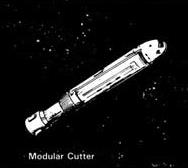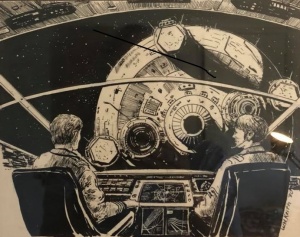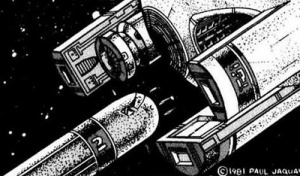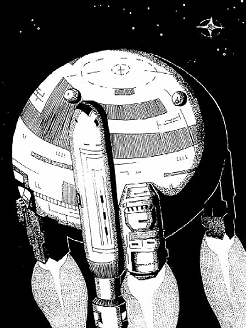Modular Cutter
| Generic Modular Cutter | |
|---|---|
 A typical modular cutter design. | |
| Type: UMC Modular Cutter | |
| Category | Smallcraft |
| Size | 50 Tons |
| Hull Configuration | Cylinder Hull |
| Streamlining | Streamlined Hull |
| Tech Level | TL–12 |
| Engineering | |
| Computer | Model/1 |
| Jump | J-0 |
| Maneuver | 4 G |
| Armaments | |
| Hardpoints | 2 |
| Accommodations | |
| Staterooms | 0 |
| Personnel | |
| Crew | 2 |
| Officers | 2 |
| High/Mid Passengers | 0 |
| Payload | |
| Cargo | 30.0 Tons |
| Fuel tank | 0 Tons |
| Construction | |
| Origin | Third Imperium |
| Manufacturer | Ling-Standard Products |
| Year Operational | Unknown |
| End of Service | Still in active service. |
| Price | |
| Cost | MCr28 |
| Architect fee | MCrMarc Miller |
| Statistics | |
| Quick Ship Profile | UMC-5S40 |
| Images | |
| Blueprint | Yes |
| Illustration | Yes |
| Source | |
| Also see | Utility Craft - Smallcraft - Modular Ship |
| Canon | Published, fan design |
| Era | 1105 |
| Reference | Starships 18. |
| Starships are designed with the Classic Traveller format, using High Guard generation. | |
The Modular Cutter uses a 50-ton hull, is capable of 4-G, carries two tons of fuel, and has a crew of two. [1]
- It is a civilian ship, a utility craft, a modular ship, and a noncombatant smallcraft.
- The Modular Cutter is known more simply as the Cutter in many records. [2]
- It uses specialized cargo containers known very generically as Modular Cutter Modules.
- It is also known as the Type UMC class Modular Cutter. It typically comes in a 50 ton smallcraft variation, but other variations are possible.
Description (Specifications)
It has 30 tons committed to special detachable modules; it has 2.5 tons of excess space available for weaponry, computer, and maybe a couch for a third crewmember. The cutter may mount up to two lasers; remaining weapons must be missile racks or sandcasters. The cutter, without any modules, typically costs MCr28. [1]
The Cutter displaces 50 tons, carries up to 12 passengers, and is capable of accelerations of up to 4-Gs. Cargo hold capacity and fuel tankage each equal 15.0 tons. Standard armament is one beam laser.
Image Repository
- A stock Modular Cutter image by a famous starcraft artist.

- A Modular Cutter coming in for a docking to a mothership.

- A Modular Cutter exiting the hangar of a Type C class Mercenary Cruiser.

- A Broadsword-class exiting an atmosphere with a modular cutter.

- A Broadsword class Mercenary Cruiser with a Modular Cutter in orbit over a blue world.

- A Broadsword-class deploying a Modular Cutter with a standard cargo module.

General Description & Deck Plans
No information yet available.
Basic Ship Characteristics
Following the Imperial Navy and IISS Universal Ship Profile and data, additional information is presented in the format shown here. The small craft factor indicates the number of squadrons (of ten craft) carried on the ship. Tonnage on the universal ship profile is shown in kilotons (thousands of tons) when necessary. [3]
| Basic Ship Characteristics [4] | ||
|---|---|---|
| No. | Category | Remarks |
| 1. | Tonnage / Hull | 50-tons. Streamlined Cylinder Hull with Modular Ship technology. |
| 2. | Crew | x2 crew. |
| 3. | Performance | Propulsion:
|
| 4. | Electronics | Model/1 fib ship computer. |
| 5. | Hardpoints | x1 hardpoints. |
| 6. | Armament | The normal weapons fit-out for it is:
|
| 7. | Defenses | A small Electronics Defensive Suite is normally equipped. |
| 8. | Craft | None. |
| 9. | Fuel Treatment | None. |
| 10. | Cost | MCr28.02 |
| 11. | Construction Time | 6 months to build, 3 months in quantity. |
| 12. | Remarks | Other Equipment:
|
Selected Cutter Modules
Three modules are routinely available for the cutter:
- The ATV Module, which includes either a wheeled or a tracked ATV, masses thirty tons. It can deposit an ATV on a world surface, as well as pick it up again later. The module can serve as an ATV storage location, if desired. It typically costs MCr1.8.
- The Fuel Module, with 30 tons of fuel tankage, serves as a fuel skimming vehicle and can be used to ferry fuel from point to point. It costs MCr1.
- The Open Module is a customizable frame with 30 tons of excess space which can be allocated to passenger couches, fuel, cargo, cabins or staterooms. It typically costs MCr2. [1]
Most Common Standardized Smallcraft Types
- Cutter (50-ton)
- Fighter (10-ton)
- Launch (20-ton)
- Pinnace (40-ton)
- Ship's Boat (30-ton)
- Shuttle (95-ton)
- Slow Boat (30-ton)
- Slow Pinnace (40-ton)
History & Background (Dossier)
The Cutter was one of the first smallcraft to be purposefully built with modular components. This makes them easily repairable with spare parts and components that are widely available. It is purposefully built to accommodate parts of higher or lower end technologies. It has become one of the eight most popular and commonly encountered smallcraft designs found within Charted Space. [5]
The Modular Cutter is known more simply as the Cutter in many records. Before the First Civil War, most cutters lacked most of the modular features now inherent to the contemporary modular cutter. Naval Architects on the Imperial Fringe had begun create innovations on the basic design, which later resulted in today's Modular Cutter. By 622 IC, the new "modular cutter" designs had spread throughout Imperial Space and beyond. [6]
Some believe that Ling-Standard Products originated the designs although there isn't a consensus to this assertion. Regardless, LSP Modular Cutter designs remain popular on the smallcraft market and LSP advertises them as such. [7]
Cutter the Smallcraft vs. Cutter, the Escort
The term cutter has a lot of history... At one time in history, especially history, cutter meant a small ship, something that could be sailed across seas, a sort of analogue to a corvette or frigate. It also concurrently meant a small away craft, a sort of boat. In the Charted Space of contemporary times, cutter most often means a smallcraft, which is to say a small vessel between one and ninety-nine tons in displacement. However, occasionally the other meaning of the word is used for an Adventure Class Ship (ACS) between one hundred and 2,499 tons in displacement. Rarely is a craft called a cutter that is larger. [8]
Class Naming Practice/s & Peculiarities
Cutters are ubiquitous throughout Charted Space and the modular cutter has gradually come to replace the original non-modular cutter. They serve every possible function and are named with many different schemes from the names of famous merchant marine officers to naval officers to manufacturing planet of origin... And more... Some of the earliest modular cutters were named after minerals such as diamonds, metals, etc. There are so many of them flying that its hard to imagine a naming scheme that hasn't been used for them before. [9]
Selected Variant Types & Classes
Civilian Ship - Smallcraft - Utility Craft - Cutter:
References & Contributors (Sources)
| This article has metadata. |
| This page uses content from Wikipedia. The original article was at Cutter_(boat). The list of authors can be seen in the page history. The text of Wikipedia is available under the Commons Attribution-ShareAlike 3.0 Unported License. |
- Marc Miller. Starships (Game Designers Workshop, 1977), 18.
- Loren Wiseman. "LSP Modular Cutter." Journal of the Travellers' Aid Society 05 (1980): 6-9.
- Marc Miller. Imperial Encyclopedia (Game Designers Workshop, 1987), 81.
- Rob Caswell, William W. Connors, Joe Fugate, Gary L. Thomas. Starship Operator's Manual (Digest Group Publications, 1988), 58.
- S.R. Greene. SGS: Imperial Small Craft (Seeker Gaming Systems, 1992), TBD.
- S.R. Greene. SGS: Imperial Small Craft Vol. 2 (Seeker Gaming Systems, 1992), TBD.
- Dave Nilsen. Reformation Coalition Equipment Guide (Game Designers Workshop, 1994), 142-145.
- Frank Chadwick, Dave Nilsen. "Technical Booklet." Brilliant Lances (1994): 47.
- Don Perrin. Starships (Imperium Games, 1996), 18-19.
- Loren Wiseman. Deck Plan 2: Modular Cutter (Steve Jackson Games, 2001), 1.
- Loren Wiseman. Deck Plan 4: Assault Cutter (Steve Jackson Games, 2001), 1.
- Loren Wiseman, Andy Akins. Modular Cutter (Steve Jackson Games, 2001), 1-128.
- Martin Dougherty. Scout Ships (Avenger Enterprises, 2007), TBD.
- Citation Missing - Mongoose Traveller Main Rulebook
- Marc Miller. T5 Core Rules (Far Future Enterprises, 2013), TBD.
- Traveller Wiki Editorial Team
- Author & Contributor: Lord (Marquis) and Master of Sophontology Maksim-Smelchak of the Ministry of Science
- ↑ 1.0 1.1 1.2 Marc Miller. Starships (Game Designers Workshop, 1977), 18.
- ↑ Information provided to the library by Maksim-Smelchak
- ↑ Timothy B. Brown. Fighting Ships (Game Designers Workshop, 1981), 10.
- ↑ Timothy B. Brown. Fighting Ships (Game Designers Workshop, 1981), 10.
- ↑ Information provided to the library by Maksim-Smelchak
- ↑ Information provided to the library by Maksim-Smelchak
- ↑ Information provided to the library by Maksim-Smelchak
- ↑ Information provided to the library by Maksim-Smelchak
- ↑ Information provided to the library by Maksim-Smelchak